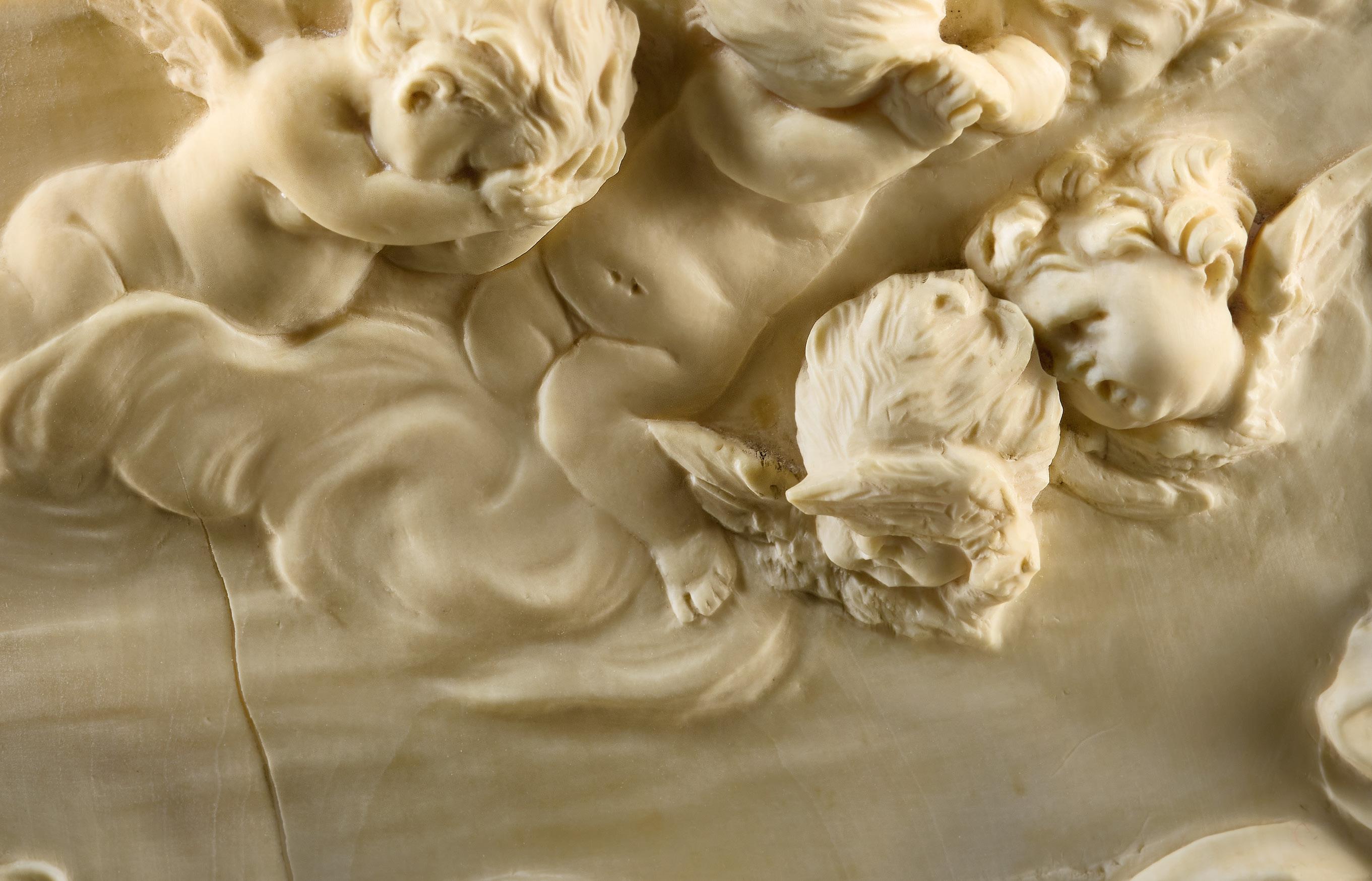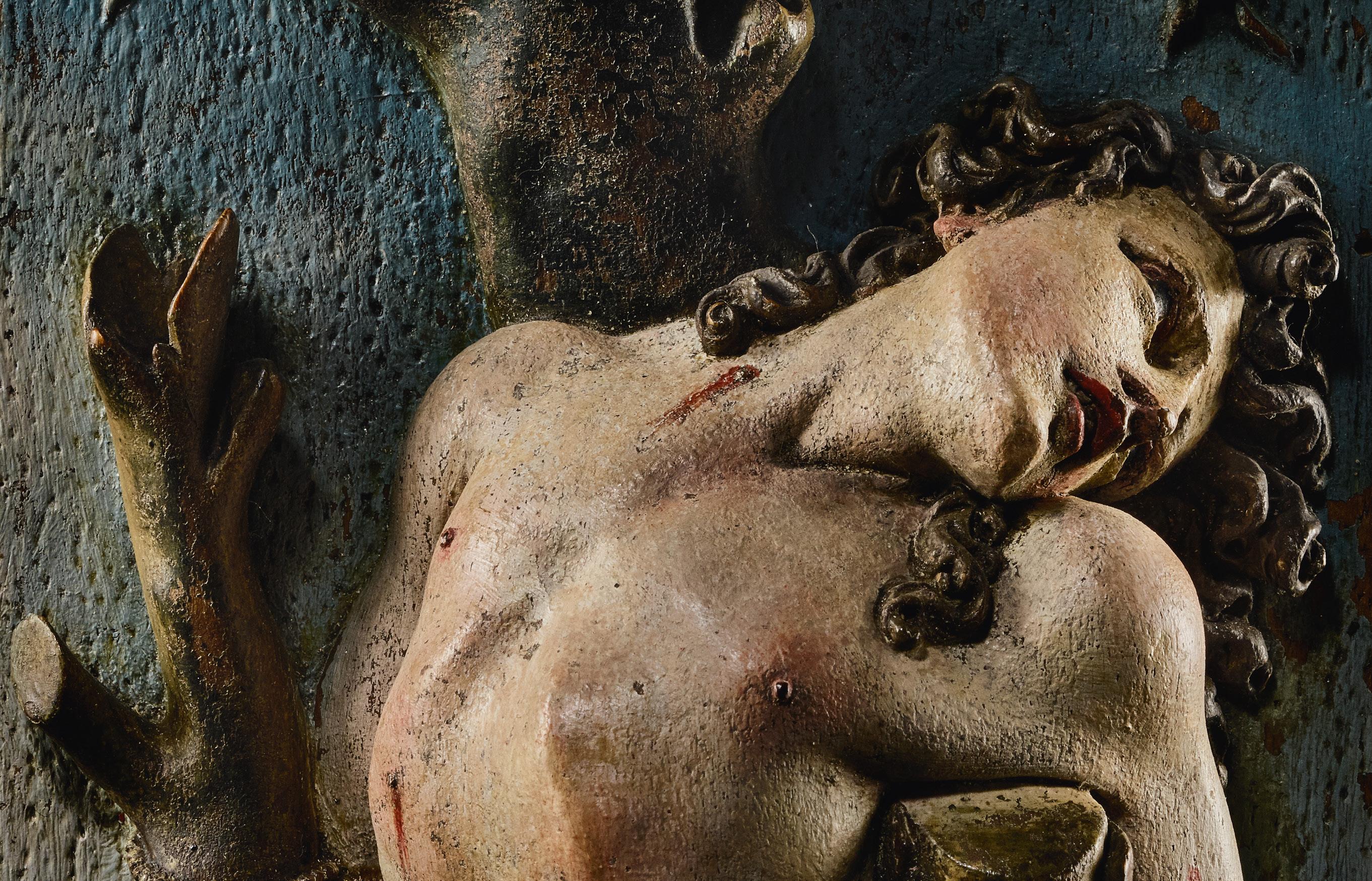
11 minute read
12 Two Wings of a Small Altarpiece with Scenes of the Life of Christ
(ATTRIBUTED TO)
Advertisement
23
RELIEF WITH SAINT SEBASTIAN
CHRISTOPH DANIEL SCHENCK attributed to
Constance, 1633–1691
Fruitwood, with the original polychromy Height: 15.5 cm, width: 11.3 cm
Provenance: Private Collection, South Germany.
Related Literature: Christoph Daniel Schenck 1633–1691, exh. cat., Konstanz/Freiburg/Stuttgart, Sigmaringen 1996. Saint Sebastian, in extreme pain, is bound with his back to a tree; both arms are pulled backwards and are tied to the stumps of branches with ropes. The position of his arms forces the saint, shown only as a half-length figure, to twist his naked torso which is covered with bleeding arrow wounds. His head leans to the side and back; his eyes look heavenwards. In addition to the martyrdom, conveyed through the saint’s expressive features, Schenck accentuates the young man’s youthful beauty through the head of curls and the red lips.
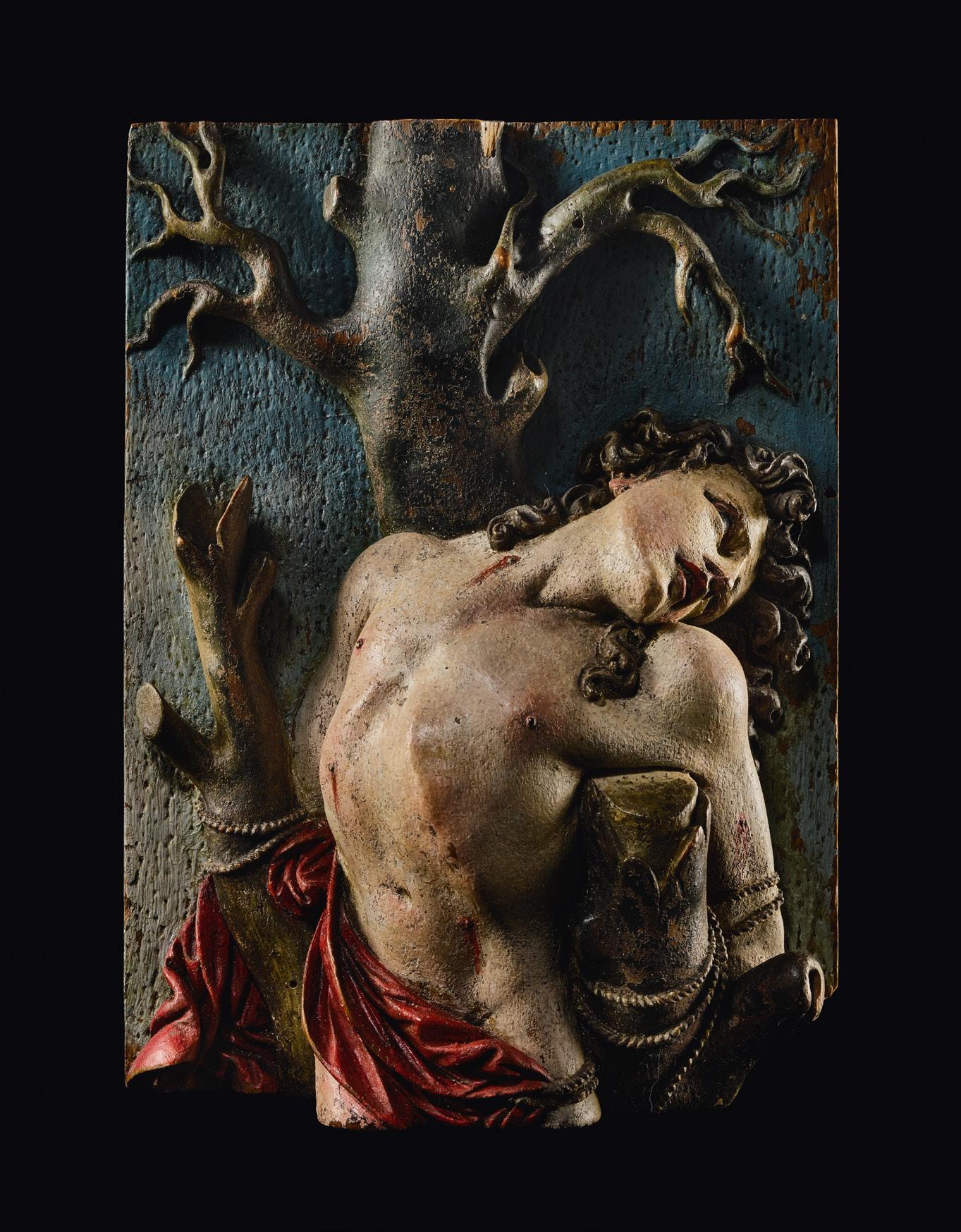
Among the works definitively attributed to Christoph Daniel Schenck there are several depictions of Saint Sebastian. The most important is doubtlessly the so-called ‘Stuttgart Sebastian statuette’.1 The ivory figure is signed by the artist and dated – the blackened engraving on the stone at the saint’s feet reads: ‘C.D. Schenck/inv et sculpt./19. Nov. Anno 1675/Constantiae’ . The masterly execution of pathos, the expression of suffering borrowed from Laocoön and the full head of hair are striking. Behind this is the artist’s intention to shock the pious viewer to the core when faced with the tormented martyr in his role as the imitatio Christi. To move believers emotionally and lead them to the ‘true faith’ of the Catholic Church, was an artistic concept of the Counter-Reformation used to great effect.
23
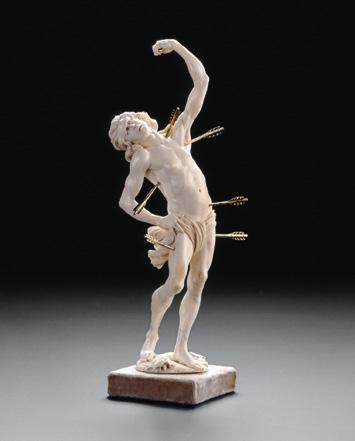
Fig. 1. C. D. Schenck, Saint Sebastian, ivory, signed and dated 1675, Württembergisches Landesmuseum, Stuttgart, inv. no. 1954–366
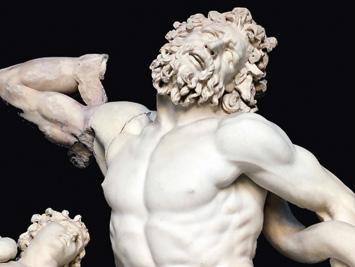
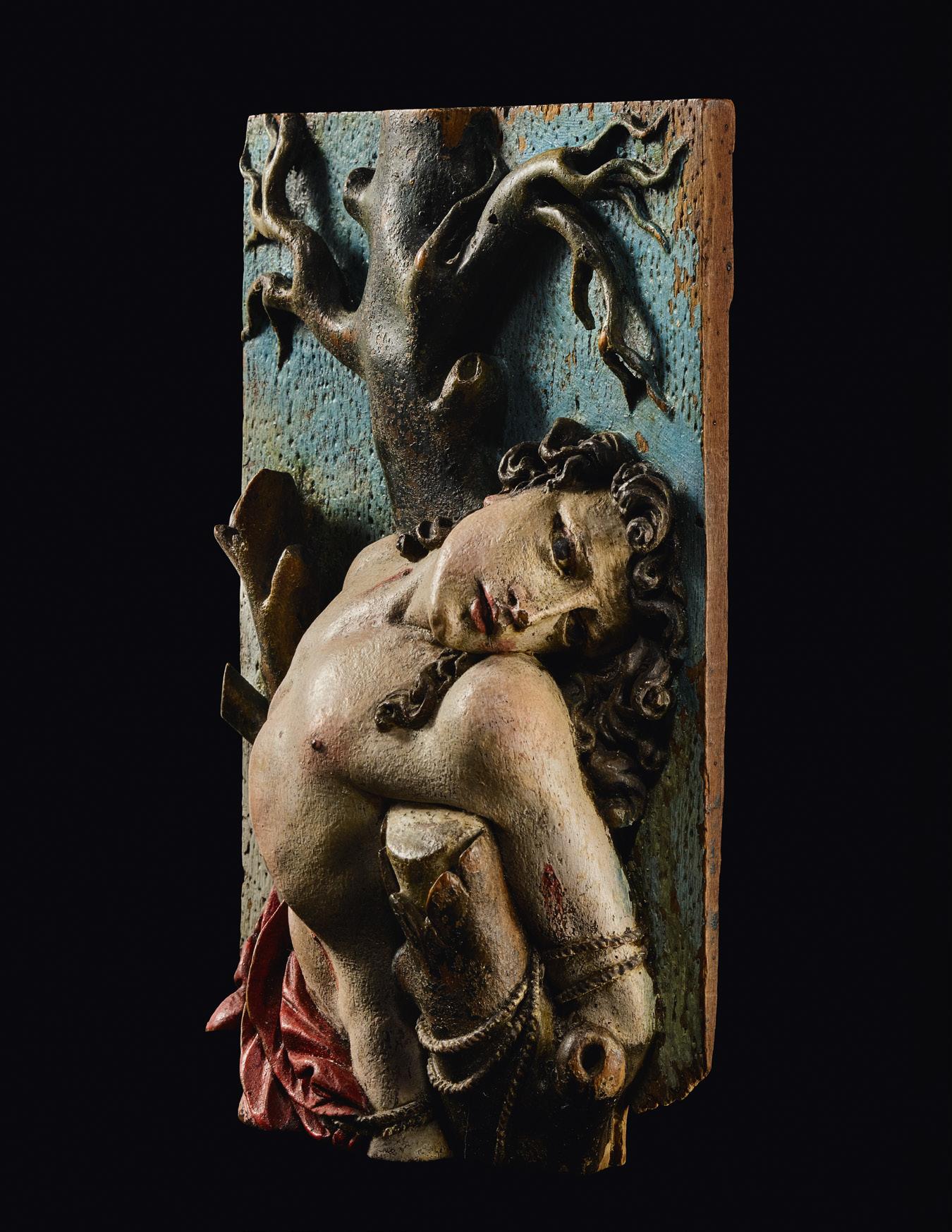
Fig. 2. Laocoön Group, detail, Roman marble copy based on Greek prototype, 1st century BC or AD, Vatican Museums, Rome
23
Compared to the so-called ‘Stuttgart Sebastian statuette’ mentioned above, our relief is probably created later. Schenck makes use of the stylistic motifs available with masterly confidence: the martyr’s tree, suggesting a landscape, is set against a blue background covered with punchmarks – which are typical of many of Schenck’s works – and that simultaneously creates a spatial architecture for the pictorial surface. The head, dramatically stretched backwards, is modelled once again on the figure of Laocoön, to which Fritz Fischer refers in the exhibition catalogue of works on Christoph Daniel Schenck.2 The motif here, however, is artistically further refined.
1 Christoph Daniel Schenck, exh. cat., 1996, op. cit., cat. no. 1, pp. 114–16, colour plate 1 2 Ibid., p. 116
Saint Sebastian
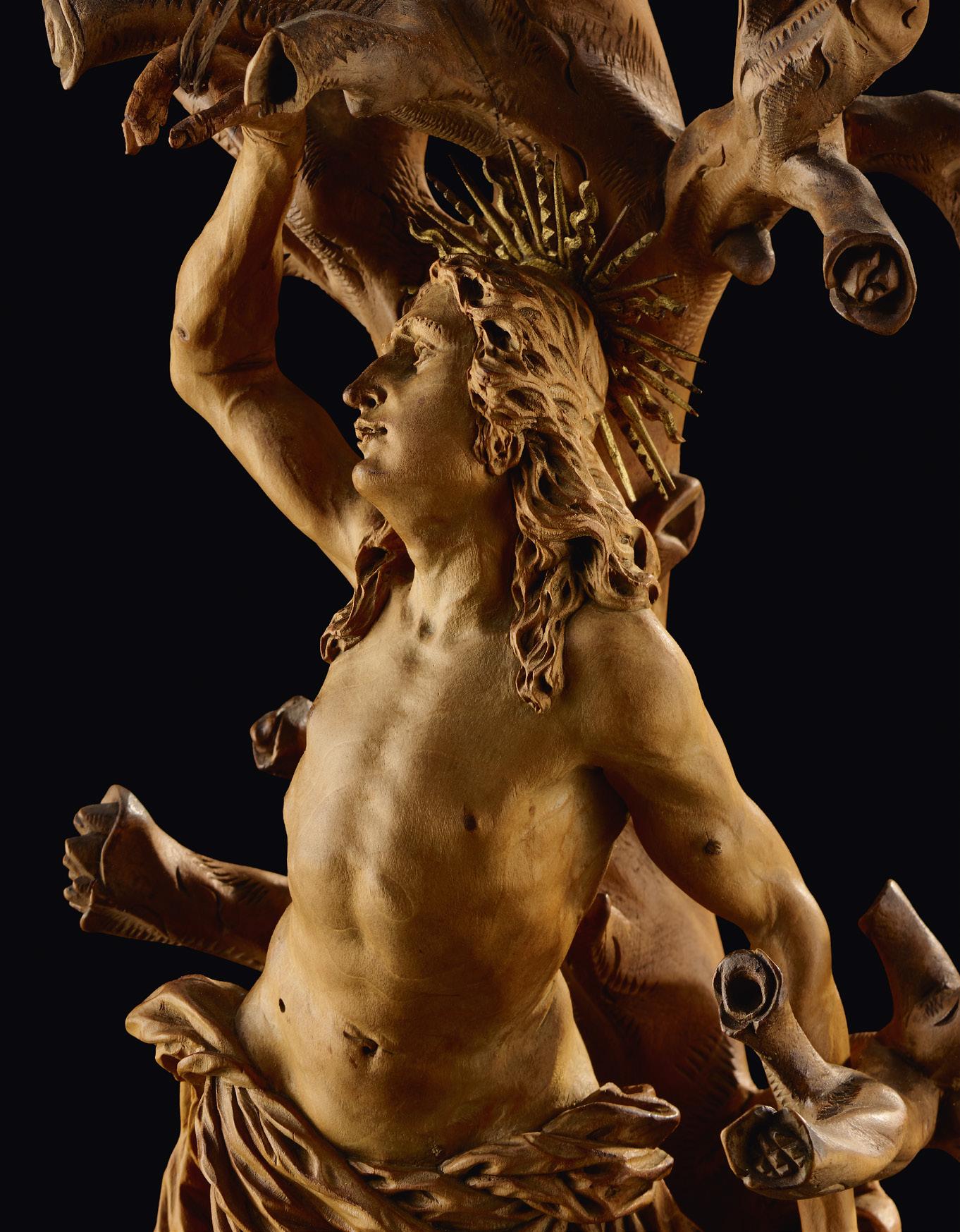
24
SAINT SEBASTIAN
Southern Germany (Bamberg?)
On the pedestal coat of arms of the Prince-Bishop of Bamberg, Marquard Sebastian Schenk von Stauffenberg Inscribed ‘Vorch’ and dated ‘1689’
Fruitwood, on the original pedestal Height of figure: 33.5 cm Height of pedestal: 13.5 cm
Provenance: Commissioned in 1689 by the Prince-Bishop of Bamberg, Marquard Sebastian Schenk von Stauffenberg (Eichstätt 1644–1693 Bamberg); Private Collection, South Germany.
Related Literature: Wunder, Gerd. ‘Marquard Sebastian’, in: Neue Deutsche Biographie 16 (1990), p. 238 f. (online version); URL: http://www.deutsche-biographie.de/.html
Haus der Bayerischen Geschichte, Klöster in Bayern, Forchheim, Franziskanerkloster, (online version); URL: https://www.hdbg.eu/kloster/index.php/detail/ geschichte?id=KS0099
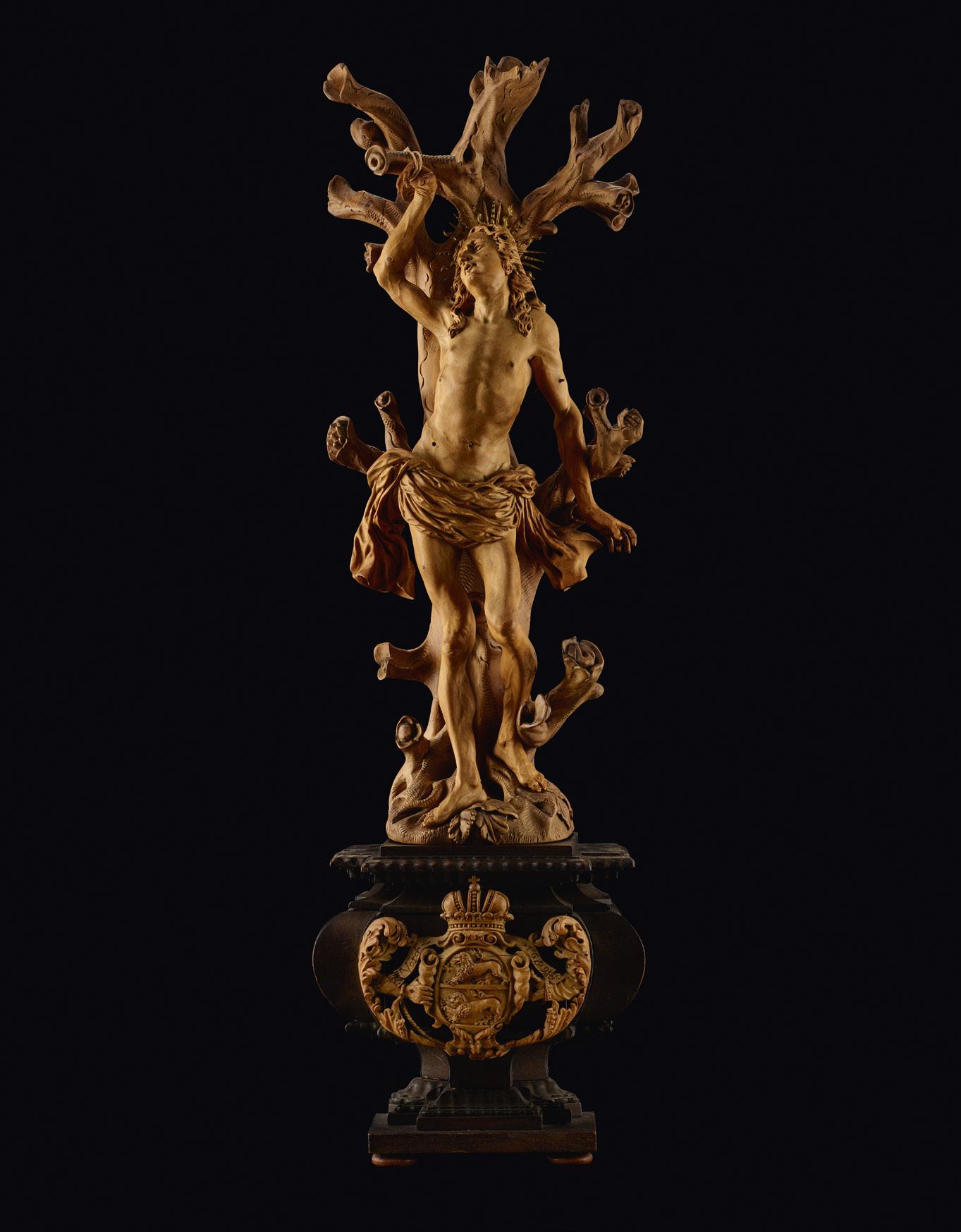
24
Saint Sebastian is shown in a marked contrapposto against the tree where he suffered as a martyr after being shot with arrows. His right hand is bound above him to a fork in a branch. The anatomy of the figure – unclothed except for a loincloth – is depicted in detail and the body language expressively heightened.
The coat of arms on the pedestal refers to the person who commissioned the work – the Prince-Bishop of Bamberg, Marquard Sebastian Schenk von Stauffenberg (Eichstätt 1644–1693 Bamberg) who held this office from 1683 onwards.
At the age of nine Marquard Sebastian Schenk von Stauffenberg was already in receipt of a canon’s stipend in Bamberg and Würzburg. He started his studies in Ingolstadt in 1658 and took his vows as a subdeacon in 1672. In 1665 he inherited the socalled ‘Echterhaus’ in Judengasse in Bamberg that has since been known as the ‘Stauffenberghaus’. After his father’s death in 1679 he took on the Amerdingen manorial estate near Nördlingen, together with his two brothers, that had been in the ownership of the Schenk von Stauffenberg family since 1566.
Marquard was elected prince-bishop in 1683 but was not ordained as a priest until 1687. He was considered an able diplomat and a benefactor of the order of which he was head. He also successfully managed the family’s estates. By increasing revenue he considerably reduced the debts incurred by his predecessor, Prince-Bishop Peter Philipp von Dernbach and reformed the administrative structure of the bishopric.
The improved financial situation put him in a position to be able to commission a number of works of art. He had Saint Martin’s church in Bamburg built as well as the Franciscan monastery in Forchheim. Plans were drafted in 1685 to convert Seehof Palace into a summer residence for the prince-bishops that, revealingly, has gone down in history as the ‘Marquardsburg’. He contracted the Italian architect Antonio Petrini to carry out the work together with a number of other artists and sought the advice of the Dientzenhofer family of builders and architects from Upper Bavaria.
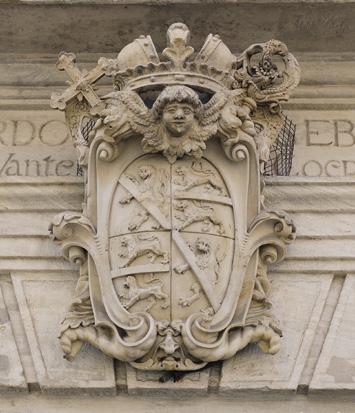
Fig. 1. Church of the Franciscan convent in Forchheim, entrance with the coat of arms of the Prince-Bishop of Bamberg, Marquard Sebastian Schenk von Stauffenberg: parted quarterly; alternately the coat of arms of the Stauffenberg family (lion top and bottom, bar in the middle) and the coat of arms of the bishopric of Bamberg (lion diagonally crossed by bar)
The inscription ‘Vorch’ that can be seen on the coat of arms is an abbreviation of the name of the town Forchheim – the most important fortified settlement within the prince-bishopric of Bamberg. As Bamberg did not offer sufficient protection from enemy attacks, the prince-bishops of Bamberg withdrew to Forchheim in unsettled times together with the cathedral treasure.
Erected as an imperial stronghold, Forchheim became a seat of the prince-bishops in the late 14th century. Prince-Bishop Marquard’s sister, Katharina Sophie von Eyb, had a large residence built there in 1685 with her brother’s help that, from 1694 onwards, was used as an official seat of the prince-bishops. The foundation stone for the Franciscan monastery in Forchheim was laid in 1684 on behalf of the Prince-Bishop of Bamberg, Marquard Sebastian Schenk von Stauffenberg. On 6 April the following year, building work on the monastery church began in the presence of the prince-bishop himself. Marquard Sebastian was also the benefactor of the Sebastian Chapel that was dedicated to his namesake. The completed monastery church and the chapel were inaugurated on 9 October 1693, five months before the prince-bishop’s death. On his deathbed Marquard Sebastian stipulated that his heart be interred in the monastery church in his chapel.
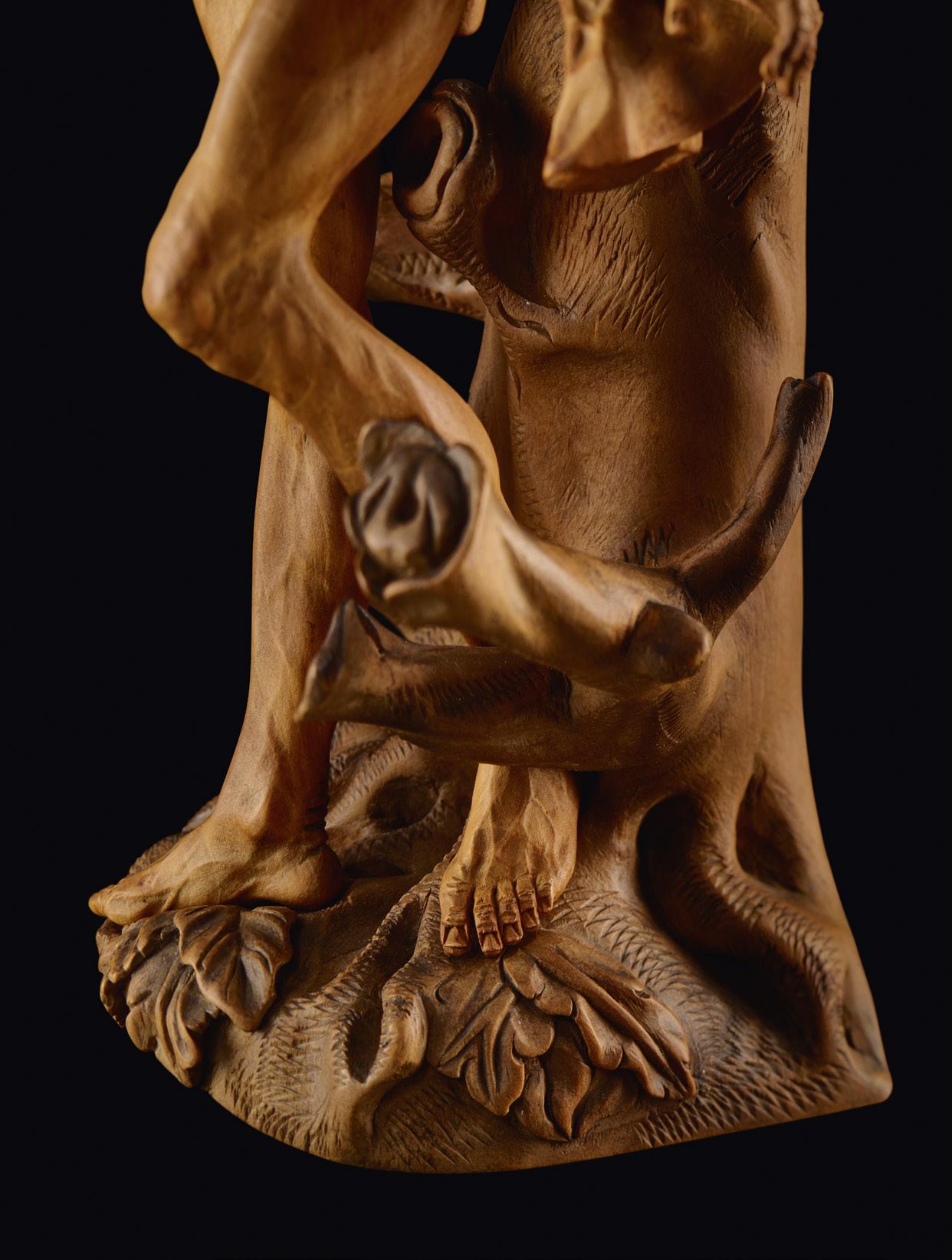
Above the portal of the monastery church that is dedicated to Saint Anthony of Padua, the founder’s coat of arms can be seen and the Latin form of his name read in the inscription ‘Marquardo Sebastiano’ on the frieze behind. The coat of arms shows the two lions from the Stauffenberg family crest as well as a single lion for the bishopric of Bamberg in keeping with the arms of alliance at Schloss Seehof. As already mentioned, the coat of arms of the Schenk von Stauffenberg family, with an imperial crown above, decorates the pedestal on which our figure of Sebastian stands. This symbolises the diocese of Bamberg as an imperial prince-bishopric. By reason of the inclusion of the family coat of arms, this figure of the princebishop’s namesake was probably intended for Marquard’s private apartments although a place on an altar in the Sebastian Chapel would also be plausible.
The name of the artist who carved this figure of the saint with such masterly skill is unknown. Prince-Bishop Marquard would certainly not have commissioned artists from Bamberg or Forchheim alone. He maintained close contact with his family’s roots in Swabia, so it is equally possible that it was made by an unknown sculptor from that region.
24
Ceres, Allegory of Summer Ferdinand Tietz
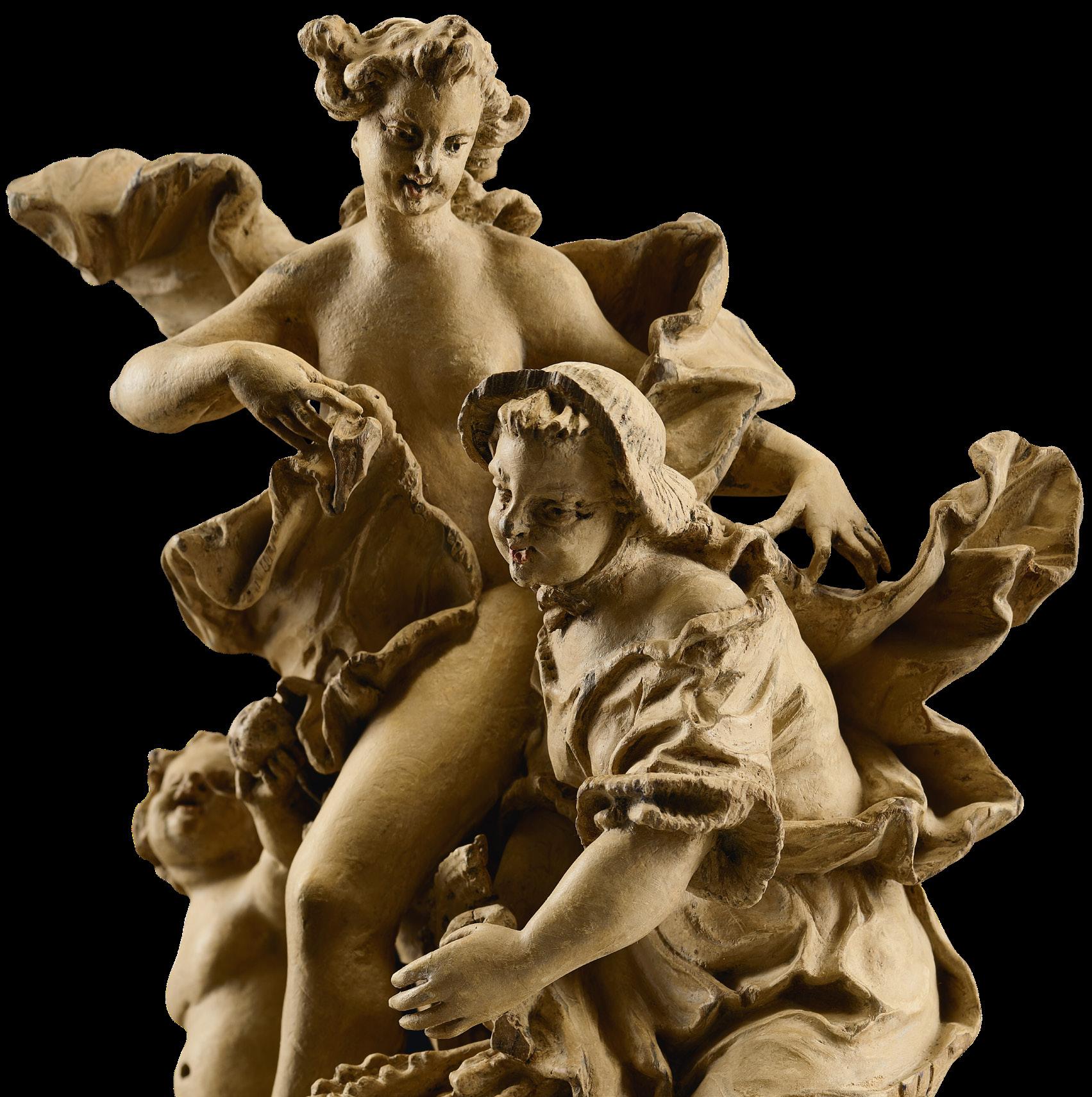
25
CERES, ALLEGORY OF SUMMER
FERDINAND TIETZ
Holešice, Bohemia, 1708–1777, Seehof near Bamberg, Germany
Height: 30 cm Bozzetto, lindenwood with the original polychromy to imitate sandstone
Provenance: Jacques Kugel, circa since the 1960s; By descent.
Related Literature: Brassat, Wolfgang. Ferdinand Tietz, 1708–1777: Symposion und Ausstellung anlässlich des 300. Geburtstags des Rokoko-Bildhauers, Petersberg 2009.
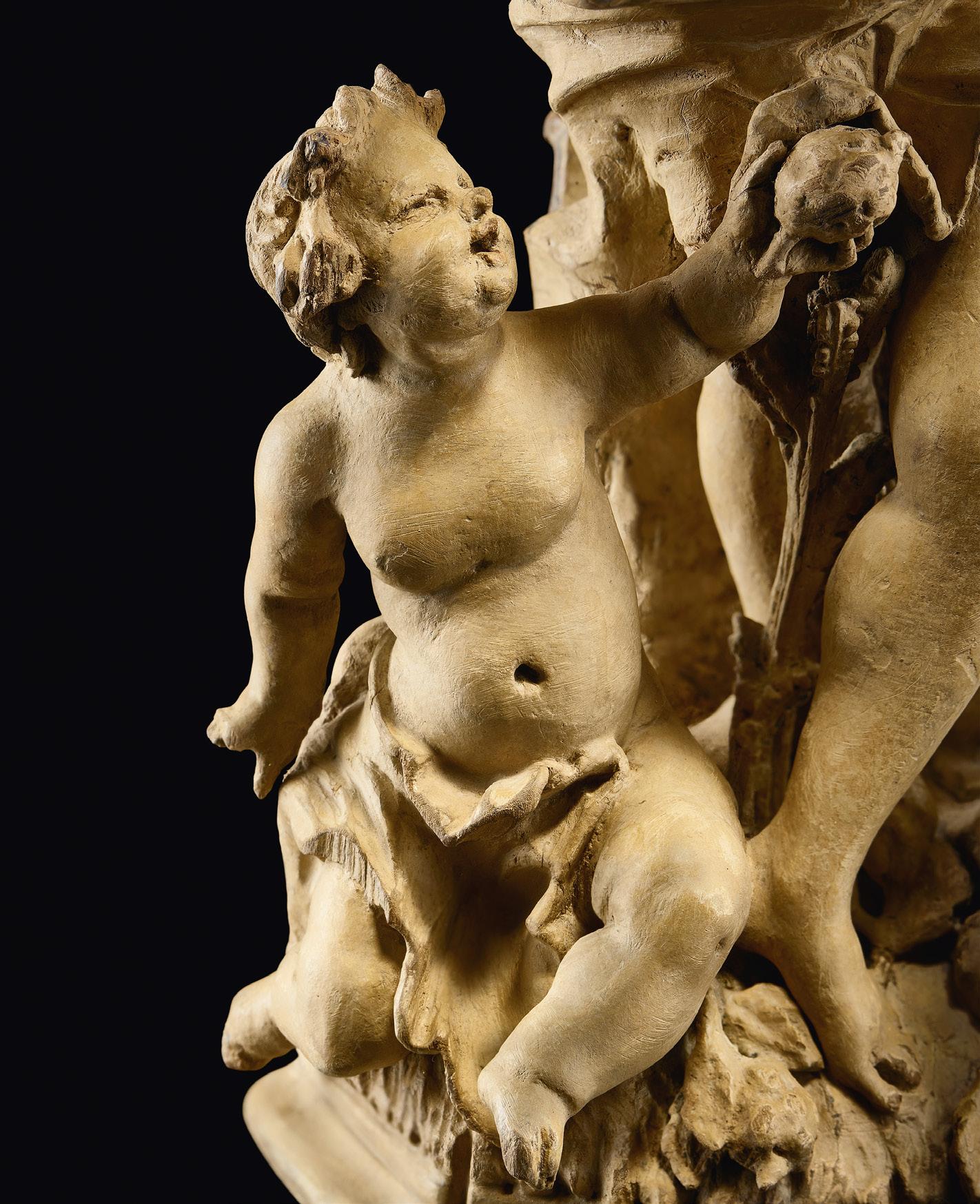
Lindemann, Bernd Wolfgang. Ferdinand Tietz 1708–1777, Weißenhorn 1989, cf. fig. 14 (Allegory of Summer), 109 (Pan), 342 (Mercury).
Trenschel, Hans-Peter. Die Bozzetti-Sammlung – Kleinbildwerke des 18. Jahrhunderts im Mainfränkischen Museum Würzburg, Würzburg 1987. Not far from Bamberg is the former summer residence of the prince-bishops, the beautiful palace known as Schloss Seehof. It is an impressive testimony to the once so impressive court upheld by the bishopric and, at the same time, it is the artistic legacy of one of the greatest Rococo artists of southern Germany, Ferdinand Tietz, who originally came from Bohemia.
Born in Holešice in 1708, as Ferdinand Dietz, he later changed the spelling of his surname to ‘Tietz’. He came from a family of craftsmen; his father was a sculptor and had a workshop in Jezeří. Although Ferdinand was later to become a successful sculptor there is no documentary evidence covering the first third of the artist’s lifetime. He most probably went to Vienna where he met the sculptor Johann Wolfgang von der Auwera (1708–1756), as stylistic parallels reveal. It is not until 1736, when he was twentyeight years old, that the artist is mentioned in archival records. He worked under Balthasar Neumann (1687–1753) on large projects in the Würzburg Residenz, as shown on various invoices. In 1747 Tietz was summoned to Bamberg by Prince-Bishop Johann Philipp Anton von Franckenstein (1695–1753) who commissioned him to devise a comprehensive plan of figures for the park at Schloss Seehof. This project represents the highlight of the park’s overall design and Tietz’s artistic breakthrough. Together with his workshop, Tietz – who was appointed court sculptor in 1748 – completed some 400 masterly worked and powerfully modelled sculptures of playfully exuberant figures captured in motion. They were to make the artist famous well beyond the region.
In 1754 Tietz was called to Trier by the prince-bishop Franz Georg von Schönborn (1682–1756) and did not return to Bamberg until 1760 where, in the meantime, Adam Friedrich von Seinsheim (1708–1779), Prince-Bishop of Würzburg, had taken over the prince-bishopric office in Bamberg as well, as the position had become vacant.
25
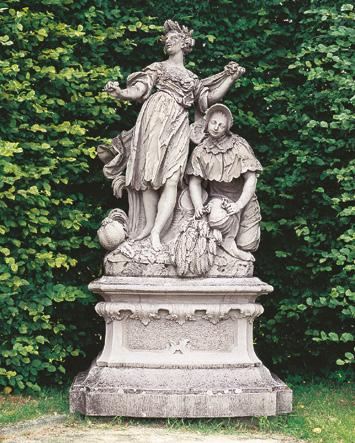
Fig. 1. Allegory of Summer, Ferdinand Tietz and workshop, 1765–66, sandstone sculpture, Veitshöchheim, garden, now in Würzburg, Museum für Franken, Staatliches Museum für Kunst- und Kulturgeschichte
In 1765 Seinsheim commissioned Tietz to submit new designs for the court garden at Veitshöchheim near Würzburg. To accompany the architectural plans he devised a comprehensive sculptural agenda. The court sculptor made a major contribution to peopling the garden with allegorical stone figures from mythology between 1765 and 1768. Upon completion in 1776, some 300 figures decorated the garden, of which some 200 have survived. They were originally painted à la porcelaine to make them look like China porcelain. That would certainly have made an impressive sight. In 1767 Ferdinand Tietz was also appointed court sculptor in Würzburg. However, after completing his commissions for Würzburg and Bamberg he did not receive any further work of note. His playful style reflecting the zeitgeist of the Rococo period was no longer in keeping with the increasingly sobre and seemingly harsh lines of emerging art tastes. Tietz died in 1777 at the age of 69 in Seehof near Bamberg.
Our figurative group is a so-called bozzetto, a small sculptural work made of lindenwood used as a model that would have been presented to the patron who gave the commission, presumably Adam Friedrich von Seinsheim, before work started on the large sculpture in stone.
A youthful-looking, nude woman is depicted in a dynamic pose standing on an octagonal pedestal with sweeping concave curves and a central floral relief. A small putto and woman in peasant’s garb kneeling at her feet proffering a sheaf of grain, form her entourage. The ripe corn is an attribute of the Roman goddess Ceres and reveals the sensual beauty as an allegory of summer.
The bozzetto is similar to an allegory of summer that Tietz made in 1765–67 for the court garden at Veitshöchheim in which the motif of the kneeling peasant woman with a gift of grain also appears (fig. 1). The small putto, however, is not included and the goddess is clothed. The virtuosity and dynamism of the small sculpted work are lacking; instead the garden figure exudes a calm majesty. In the case of the garden figure Tietz also eschewed the sensually erotic aesthetic and gleeful exuberance that characterise the bozzetto, presumably at the request of the patron.
Due to the work’s high artistic quality and taking stylistic comparisons into consideration we assume that this bozzetto is a work by Ferdinand Tietz himself. In all probability, the Ceres group served as a model for the Allegory of Summer in the garden at Veitshöchheim.
25
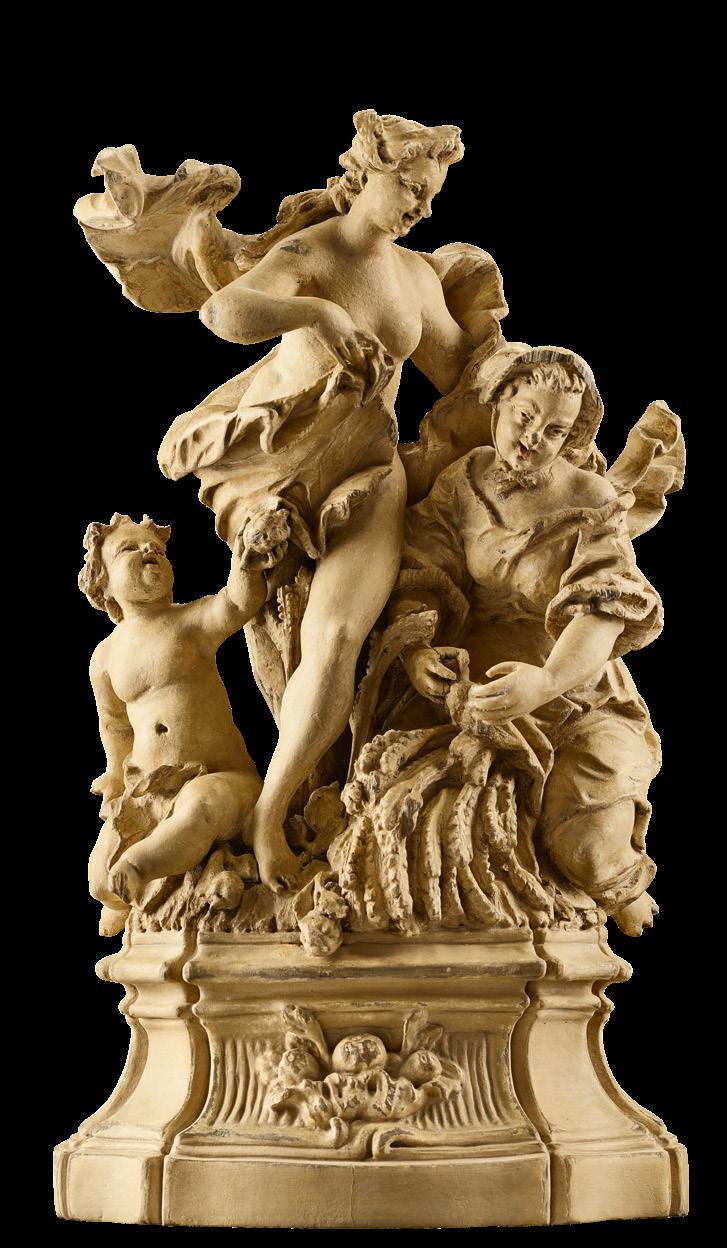
Relief with the Lamentation Balthasar Permoser
